Tara Chevrestt's Blog, page 2
October 19, 2022
Crooked Little Pieces : Book One in a Series
I was asked to read Sophia Lambton's novel, Crooked Little Pieces, by the author who had seen my reviews on this blog. This is the first book in a series which explains why it's not as resolved as a standalone novel would be.
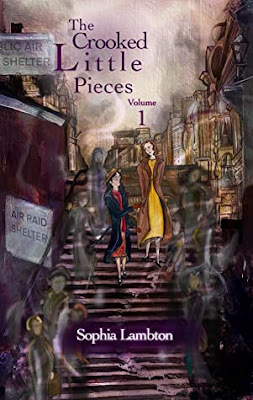
The protagonists are the sisters Isabel and Anneliese who were born six days apart. I expected to like Isabel because she is a musician, but the focus wanders away from music. I confess that I found her problematic because I am a feminist. Isabel's perspective is troubling for feminists. In addition, Isabel is antisemitic which I find offensive.
Anneliese's scholarly view is more to my taste. She is also more confident than Isabel. Isabel is incredibly lucky to have Anneliese as a sister. Anneliese's support is crucial for Isabel at some points in the narrative.
Although the prologue takes place in 1968, the first chapter opens in the 1920's when the girls were six. The novel ends in the WW II era. I expect that the second book will continue with this WWII progression.
September 30, 2022
Paths For The Divergent
A curandera was mentioned in my recent review of the mystery Shutter which centered on a Navajo woman photographer. (See my review of Shutter here .) I am now reviewing a book in which a curandera is a major point of view character. The title is Witches and the author is Brenda Lozano.
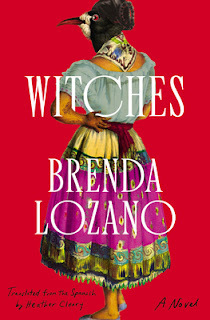
It seems to me that Witches is a somewhat misleading title. Curanderas are more specialized than witches. Witches may perform all sorts of magic. The magic of a curandera is focused on healing. She also practices a particular Mexican tradition of healing that may have similarities to magical healing practices in other cultures, yet there are also important differences. I have never believed in erasing unique aspects that occur in the variety of cultures on our planet. We can then lose wisdom, and are poorer because of it.
Wisdom is not the same as what we learn in school. I believe that the characters of Witches demonstrate that this is true. Yet there is value in schooling. Literacy can broaden your knowledge of cultures other than your own. The amazingly gifted healer Feliciana was illiterate. She learned about peoples from outside Mexico when they traveled to meet her. This normally wouldn't have happened to a woman who grew up in Feliciana's village. She would have been quite culturally isolated.
If the village had been less isolated, another divergent character could have found connections with others who were like her. Paloma was born with the name Gaspar and was raised as a male in a family tradition of men who were curanderos. Curanderos are paranormal healers. Over time Gaspar began to exhibit the female traits that were natural to her. She was attacked for becoming who she was meant to be. In Mexico she was considered a muxe, which is a third gender. She called herself Paloma. Few people in this village could accept Paloma, even though Paloma was the one who taught Feliciana who become a powerful curandera.
We learn that Feliciana and her sister Francisca first began to eat the hallucinogenic mushrooms that were tools for healing because there wasn't enough food. It's sad that a family that had been healers for generations were so impoverished.
In the next generation of what had been a family of curanderos and curanderas, the divergent one was Leandra. Leandra was a rebel who started fires and was kicked out of schools. She told her sister Zoe that she had gotten married to a girl. She asked Zoe not to tell their parents because she hadn't invited them to the wedding. I suspect her parents wouldn't have come if they had been invited. Leandra doesn't seem to have any awareness of the existence of homophobia.
Professionally, Leandra wanted to be an art photographer whose work is exhibited in galleries. The first time this happened, Leandra had three photos chosen for a group show. Leandra's work attracted the interest of a collector who specialized in Latin American woman artists.
I liked this book dealing with unconventional people very much and decided to give it a B+ which is four stars on Goodreads.
September 12, 2022
Female Navajo Photographer Protagonist in a Mystery
In order to make sure I would get a mystery read in September, I got one picked out even before I'd arrived at the halfway point. It was Shutter by Ramona Emerson. The copy I'm reviewing is a library book. The protagonist is a photographer which isn't all that unusual. I've reviewed several books with photographer protagonists -- most recently Michael Angelo & the Stone Mistress by Steve Moretti. Yet this is my first female Navajo photographer protagonist.
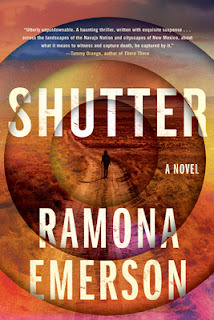
As the book opens, Navajo Rita Todacheene is a forensic photographer. This means that she photographs crime scenes. Yet she also sees spirits which isn't a trait that would be considered compatible with professionalism in most work environments. Needless to say, Rita must be careful not to reveal her paranormal gift to officers in the Albuquerque PD.
Being paranormally gifted, isn't the only way that Rita's job is problematic. I also knew that the Navajo avoid mentioning the dead or even the names of dead relatives. So it seemed to me that Rita's job was extremely incompatible with her culture.
The issue of the Navajo belief that the spirits of the dead (called "chindi" in mysteries by Tony Hillerman) could contaminate them, arose when Grandma took Rita to a church where ghosts were lingering. I wondered why Navajo spirits of the dead would linger if they believed they were contaminating people that they loved. Her grandfather's spirit worried that inimical spirits could make Rita crazy.
I was interested in the fact that Rita's neighbor was evidently a curandera. Curandismo is a a Mexican healing tradition. She rubbed Rita with an egg, then she cracked the egg into a glass of water and told Rita to put the egg in the glass of water under her bed. "Whoever has their eye on you will let you go," said the curandera. There were also jars to put in each corner of the room. Rita thought it was superstition. I think that Rita's lack of belief in the measures that Rita's neighbor was taking to protect Rita would undermine their efficacy.
<Spoilers--
Rita learned Police Lieutenant Garcia was behind most of the local distribution of meth. This was a major revelation. I wondered if Garcia did that because Latinos were being discriminated against when it came to advancement in the police department.
End spoilers.>
It was mentioned in this book that Saint Veronica is the patron saint of photography. Since I had never heard this before, I looked for a confirming link. I found it at St. Veronica which links to a page about this saint's connection to photography. Since Rita doesn't seem to be a devout Catholic, I didn't think that St. Veronica would have been significant for Rita.
There is a positive resolution to the book from a law enforcement perspective. I decided to give Shutter a B+.
May 8, 2022
Cleopatra's Dagger: A Journalist in New York in 1880
Since the last book I reviewed on this blog also had a journalist protagonist, readers will get the idea that I like journalists. They'd be right. I count ten previous reviews of books with journalist protagonists on this blog, and seven more on my other blog. I identify with journalist protagonists because I once wanted to be a reporter. I got no further toward that goal than writing for school newspapers, but that was some time ago.
I received a copy of Cleopatra's Dagger by Carole Lawrence from a publicist back in January. Many apologies for the delay. I got behind with my reviews this year. With this review, I expect to be caught up.
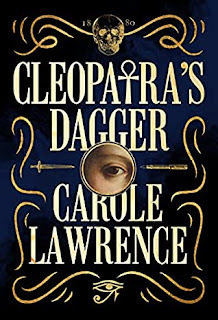
My reviews are based on voluminous notes from my book journal on every book I read. So I very much related to what the protagonist, Elizabeth, had to say about her process. "The very act of putting her impressions down on paper helped her to understand what she thought and felt."
Elizabeth's editor warned her not to trust the police. He told her about the Tompkins Square Park Riot of 1874 in which the police beat peaceful protestors with clubs. I considered this indicative of the period and what it was like. I am going to reproduce an illustration from the Wikipedia page devoted to this riot below.
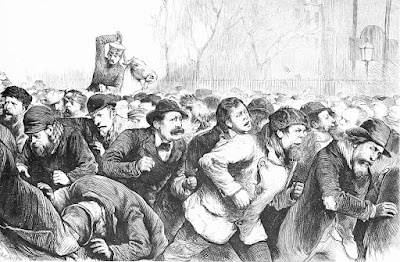
Elizabeth's family seemed to be rather well off , belonging to the late 19th century equivalent of the aristocracy of New York. Her father was concerned that being a crime reporter was an improper occupation for his daughter. I really liked Elizabeth's response. "I'm not certain it's a proper occupation for anyone...[but] I am determined it will not will not be closed to women."
According to the blog Women's Views on News , the 1880 U.S. Census recorded 288 women journalists but that their stories were much like Elizabeth's assignment to report on Mrs. Astor's garden party in this novel. Elizabeth's articles for The New York Herald on killings would have been very atypical for the period. Yet my favorite real woman journalist, Nellie Bly, was also working during this period and she sure wasn't writing about garden parties. See the section in the Wikipedia article on Nellie Bly about her career. I'm glad to see a fictional equivalent of Nellie Bly in this novel.
Elizabeth became a crime reporter when she discovered a body wrapped as a mummy on a walk, and insisted on covering the story. She convinced the detective in charge of the case that if the photo of the body was put on the front page of The New York Herald, they would find someone to identify the corpse more quickly.
When a second body was found in the East River, Elizabeth was summoned to the scene via telegram. Detective Inspector Thomas Byrnes described her jewelry and how she was dressed. Elizabeth said it sounded like this victim was dressed like the Egyptian water goddess, Anuket. There was an ankh on a leather thong hanging on her neck. I'm afraid I couldn't resist adding "Ankh if you love Anuket!" in my notes. One of the policemen who responded recognized this second victim as a prostitute named Mary Mullins.
When the mystery was resolved, it seemed anti-climactic to me. I gave the book a B.
March 5, 2022
The Choice : A Journalist Heroine in a Jewish Romance
I haven't been posting much to Flying High Reviews because the strong female protagonists that are my focus in this blog tend to be few and far between. In fact, all the books I've reviewed so far in 2022 were fiction with male protagonists or were non-fiction. So I've reviewed them on my general blog Shomeret: Masked Reviewer or posted about them more briefly on Goodreads. Author Maggie Anton sent me an advance copy of The Choice for review.
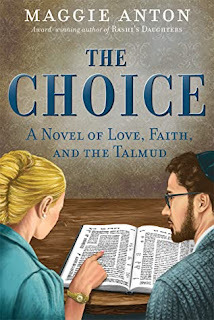
The Choice takes place in the 1950's. The attitudes were quite different from contemporary mores. That's why the main female character, Hannah Eisen, was being scandalous when she removed her gloves in a man's presence.
Back in 2014, I participated in a blog tour for Anton's novel Enchantress. That blog tour post included an interview with the author. It was the last time I reviewed a novel by Maggie Anton on this blog. You can find what I had to say about Enchantress here.
Apparently, Maggie Anton found it necessary to mention in her Author's Note for The Choice that she didn't get permission from the Potok estate. Chaim Potok's The Chosen is very far in my rear view mirror. So the issue of similarity between the two titles didn't occur to me when I was reading The Choice. I also found more than a hundred and fifty books using The Choice as a title on Goodreads. It's really pretty generic.
The male protagonist, Rabbi Nathan Mandel, discovered that women had been emigrating to what was then Palestine for 900 years. He also learned that 900 years ago women were counted as part of the minimum number for a prayer service (known as a minyan), and that they read aloud from the Torah in synagogues. Since Orthodox Jews like Rabbi Mandel don't currently count women for a minyan or allow women to read aloud from the Torah during a prayer service, this was an amazing discovery for him. I also thought this was an important revelation about the historical status of women within Judaism.
I looked up why women aren't allowed to read aloud from the Torah by the Orthodox, and found a link to Jewish Answers which said women reading aloud from the Torah implied that there were no men present who were capable of reading aloud from the Torah. It would be a disgrace to the men of that congregation. You see, men are religiously obligated to read from and teach Torah. Women aren't.
There is discussion of child sexual abuse in the Orthodox community in The Choice. It dealt with someone who was molesting boys in Orthodox Jewish schools. We learn that this wasn't just a current problem. One Lubavitcher Rebbe had been sexually abused by a mentor beginning in his boyhood and continuing long-term until he got married. That rebbe had become a patient of Sigmund Freud to deal with his trauma.
Hannah, who was a journalist, had written an article about a molester at the ultra-Orthodox girls' school which had been suppressed. She showed her article to Nathan telling him that an Orthodox clinical psychologist that they knew, who was faced with all these current sexual abuse victims, would find it interesting. Hannah later wrote an article about the same molester abusing Orthodox boys. Her editor didn't want to publish it, but he did want to circulate it because it included the information about the Jewish clinical psychologist who could help survivors of abuse. He had agreed to have his name mentioned in the article.
The relationship between Hannah and Nathan began with Nathan secretly teaching Talmud to Hannah. Teaching women Talmud wasn't allowed by Jewish law. Nathan compared his teaching her Talmud to the activities of 19th century anti-slavery abolitionists. I thought that this implied that Nathan believed women should be taught Talmud and that one day it would be permitted.
Hannah's mother asked if Nathan and his father had been at the 1949 Peekskill Riots. They had been there. Racists protesting a Paul Robeson concert had started the violent disturbance. I looked up the Peekskill riots and found a Wikipedia article here. I also found some reminiscences about his 1949 Peekskilll experiences by Howard Fast here . They were quite intense.
An important issue for Hannah and other Orthodox women was filthy poorly maintained mikvahs. These are Jewish ritual bathing facilities. Women were expected to visit mikvahs for purification after menstruation, and before intimacy with their husbands. The condition of many mikvahs contravened their purpose.
According to this novel, Columbia University accepted money from the Communist Party to establish a chair for Russian Studies. When I did a search on the establishment of Russian Studies at Columbia University, I found a statement from Columbia's Department of Slavonic Languages that the Russian Institute was established at Columbia University due to a grant from the Rockefeller Foundation in 1946. So either The Choice was taking place in an alternate universe, or the novel was very mistaken about the source of funding for the Russian Institute.
I wasn't mistaken in my impression that a relationship between the male and female protagonists was central to The Choice. I will allow readers to find out the specifics of how their relationship grew, and what it became.
December 12, 2021
Blog Tour: Review of Women of Pearl Island
I was asked to review a pre-release version of a novel called The Women of Pearl Island by Polly Crosby and read it in one day. Its release date is December 7, 2021.
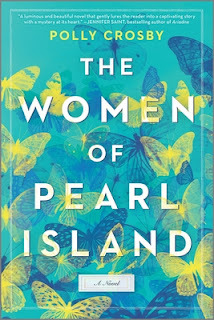
My perception was that in this book men made most of the decisions and the women's futures were determined by them. This included the decisions of the U.S. military which gave what seemed to be arbitrary orders to leave the island.
If a place is your home, and you don't have much experience of living anywhere else, I can understand the reluctance to leave.
Another issue that comes up in this book is corporate misrepresentation. Companies aren't necessarily actually selling you the product that they claim to be selling. They might be substituting something else.
I felt sympathetic toward the character Marianne being told that her fingers were too fat to play the piano. I was told that my fingers were too short to play the piano. Apparently, piano players need to have long thin fingers, and the rest of us aren't supposed to play the piano. The character Nan didn't follow those rules. She taught Marianne to play piano regardless of the supposed inappropriateness of her fingers. Bravo Nan!
Neither the military nor the corporation that was formed on the island were portrayed positively, and I respected this novel more for not idealizing them. Since an island is a microcosm, corporate misdoings take place on a smaller scale. The Women of Pearl Island was a realistic and well-written book. I was glad to have the opportunity to read it.
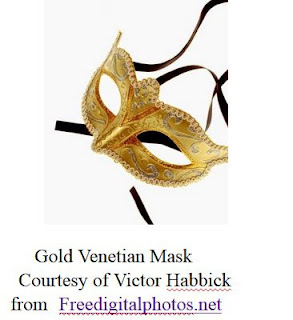
Photo of Polly Crosby
 Photo Credit: Matt Crosby
Photo Credit: Matt CrosbyJuly 31, 2021
Blog Tour: Radar Girls, A Novel of Women in the Air Raid Defense Team During WWII
I received an advance review copy of Radar Girls by Sara Ackerman from the publisher via Net Galley when I was selected for the blog tour. I prioritized the book and practically inhaled Radar Girls more than a week ahead of my post date. I found it suspenseful, and the inner strength of Daisy, the female protagonist, was very inspiring.
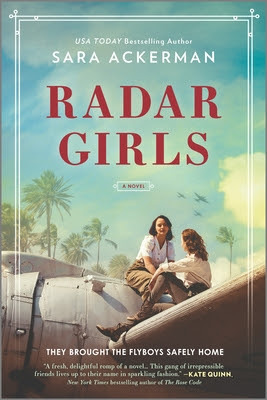
Many readers might wonder how a novel about WWII could provide any suspense because we all know the results, but we don't know what happens to Daisy and the other characters in Radar Girls. The characters put the drama in historical fiction by involving us with their lives.
According to the Author's Note, the main source for Radar Girls was a non-fiction book called Shuffleboard Pilots: The History of the Women's Air Raid Defense in Hawai'i 1941-1945 by Candace A. Chenoweth and A. Kam Napier. There were numerous incidents from Shuffleboard Pilots included in the novel.
Before Daisy became a member of the Women's Air Raid Defense team, she was a horse trainer following in the footsteps of her deceased father. There was a sub-plot about a valuable missing horse. Moon was a high spirited thoroughbred whose sire had been a race horse. Daisy felt responsible because Moon went missing when she took him riding without permission.
There is also a romance which was a will they/won't they subplot involving Daisy and a man who sets the standard for bravery and integrity very high. This American hero would stand out in any novel. My respect for him only increased over the course of the narrative.
I consider Radar Girls an engaging novel that taught me about an aspect of women's participation in WWII that I knew nothing about.
SARA ACKERMAN
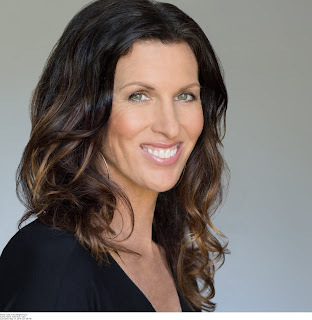 Photo by Tracey Wright-Corvo
Photo by Tracey Wright-Corvo
May 16, 2021
The Book Woman of Troublesome Creek: Skin Color As A Litmus Test For A Packhorse Librarian
I recently discovered The Book Woman of Troublesome Creek by Kim Michele Richardson which deals with a Kentucky librarian who delivers books to people in the hill country riding a pack mule in the 1930's. I love librarians and I'm interested in the hill people, so I checked this novel out of the library.
I understand that there are two other books that deal with this topic. They are The Giver of Stars by Jojo Moyes and a children's book called Wonderland Creek by Lynn Austin. I may read them because I am so interested in the way librarians and hill people are portrayed. I understand that Kim Michele Richardson lives in Kentucky, and that reviewers have considered her authentic. Since I don't live in Kentucky and have no knowledge of Kentucky hill life in the 1930's, I can't comment on the book's authenticity.
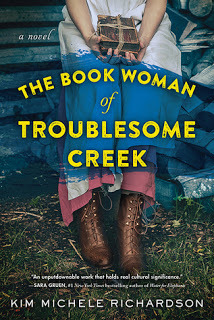
Female protagonist Cussy had a hereditary medical condition that caused her skin to be blue. This is a real genetic disease called methemoglobinemia. Her father, who also had the same condition, imagined that there was a man in Kentucky who could overlook her blue skin and marry her. This would have to be an unusual man since most people in the area were deeply prejudiced against anyone who was different. Cussy was aware of this problem, and didn't imagine she would ever marry. Besides, she found her life as a Pack Horse Librarian satisfying. She loved delivering reading material to people who had no access to libraries, and finding what they really wanted to read. Yet it's important to note that Cussy only had access to discards which were books that other libraries didn't want or need in their collections. Discards were Cussy's "new" books.
Queenie, a black librarian who had also been delivering books in the hills of Kentucky, decided to go to Philadelphia. She wrote to Cussy that there were colored doctors there who would treat her sick grandmother, and colored schools for her children. Cussy thought there were opportunities for blacks in Philadelphia, but not for blues like her. She was probably right. It was unlikely that Philadelphia would be any better for her. There wouldn't be blue doctors there, or schools for blue students.
For another perspective, I'd like to mention a novel I'd read some time ago dealing with a blue skinned alien who thought himself superior to humans. I reviewed it here .
Harriet Hardin, the assistant supervisor at the library center, was a bigoted character that I very much disliked. Yet her favorite book was The Stars Look Down by A.J. Cronin which was a sympathetic portrait of a British mining family in the 1930's. To us this would be historical fiction, but for Harriet and the other characters in this novel, it would have been considered contemporary fiction taking place in the present day. I haven't read any A. J. Cronin, but I suspect I would like The Stars Look Down myself. I have put a hold on it. So we shall see. I noted that this novel was considered similar to The Ragged Trousered Philanthropists by Robert Tressell and put a hold on that one as well.
This book also led me to a highly regarded classic, The Good Earth by Pearl Buck. Cussy was given the sequel, Sons, by a library patron who turned out to be a very pivotal character. I looked up The Good Earth and decided that I should read it. After I finish it, I'll see if I want to read its sequels.
No review that I've seen of The Book Woman of Troublesome Creek has mentioned medical research as one of the issues brought up in this novel. Doctors wanted samples of Cussy's blood. It seemed to me that the doctors were more interested in benefiting their own careers than Cussy. They gave her a drug that had side effects. Discussing the impact of the drug would be a spoiler, but I consider this racist medical research based on white supremacist ideology. I applaud Kim Michelle Richardson for showing us so vividly that medicine can be racist.
As a feminist, I was struck by Cussy receiving a letter with a Susan B. Anthony stamp and not knowing who that was, or the meaning of "Suffrage for Women" which was written beneath the stamp. I was sad that Cussy had never learned about the women who had struggled for women's suffrage, and I wondered if she had been taught about the 19th Amendment to the United States Constitution or its ratification on August 8, 1920.
The Book Woman of Troublesome Creek made me sit up and take notice of a Kentucky that was unknown to me, and showed me the tough librarians who supplied Kentuckians with books in all times and seasons.
April 28, 2021
Leaving Coy's Hill: A Novel About Suffragist Lucy Stone
I haven't posted here for a while. This is partly because I was moving in March, but I also hadn't been coming across books with strong female protagonists. I recently got hold of a book about a woman's suffrage leader which was given to me for free by the publisher.
Many readers may never have heard of Lucy Stone. In my case, I thought that Sherbrooke's novel showed a different side of Lucy Stone than the one I knew about.
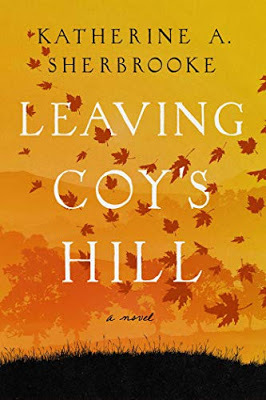
I thought of Lucy Stone solely in terms of her puritanical attacks on divorce and Victoria Woodhull, who is one of my favorite suffragists. (See what I had to say about Woodhull in my review of Seance in Sepia here , what Karen J. Hicks had to say about her Woodhull book The Coming Woman here and my review of the Woodhull novel Madame Presidentess here .) Yet there was a good deal more to Lucy Stone than I had ever imagined.
Lucy started thinking about women's rights as a child when she thought a cousin wasn't being well-treated by her husband. She told a woman friend who wanted to be a minister that the Bible was used to diminish women.Then when she was being paid to speak for the abolition of slavery by the Anti-Slavery Society, she decided that she had to speak out for women as well. When she married Henry Blackwell, she insisted on keeping her own name. At the time, this was revolutionary.
This is a book that take's Lucy Stone's perspective. It shows us where the women's suffrage movement fractured. Although both Elizabeth Cady Stanton and Lucy Stone had husbands, Susan B. Anthony chose to demonize Lucy Stone's marriage as disloyal, but not Elizabeth Cady Stanton's. I have always believed the feminists should respect women's choices. It seems to me that feminist leaders have gone wrong when they turn on each other because of life style differences. Shared goals are the foundation of feminism. Sherbrooke's novel shows that factions are unnecessary, and can have sad consequences.
February 20, 2021
A Door In The Earth: A Novel in Which an Afghani-American Returns to Afghanistan
The last time I reviewed a Goodreads giveaway win on this blog was Josephine Baker's Last Dance here . A Door Into Earth by Amy Waldman is a 2019 GR giveaway win that I just finished reading. I am still going through the stack of physical GR giveaway books in the order I received them when I have the time to read them.
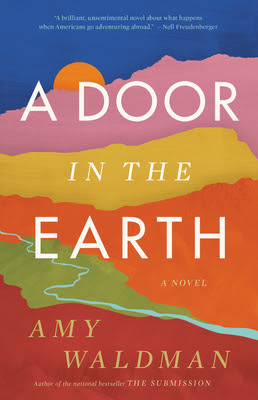
If you had told me that I was going to read a novel taking place in current day Afghanistan, I wouldn't have believed you. I looked up the status of the war. It's still going on despite the United States signing a peace treaty with the Taliban about a year ago. See recent developments .
A Door In The Earth isn't primarily about the war. The war does become prominent toward the end of the novel, but this novel centers on an Afghani-American woman in a small Afghan village with an American built women's medical clinic. Parveen Shamsa, who left Afghanistan with her parents when she was two years old, was drawn back to the land of her birth by a memoir called Mother Afghanistan written by a fictional American called Gideon Crane. She was inspired by Crane's reputation as a great humanitarian and wanted to help.
Unfortunately, sometimes reputations are built on lies. I was reminded of Greg Mortenson who was exposed in Three Cups of Deceit by Jon Krakauer. In fact, I wouldn't be surprised if Crane was loosely based on Mortenson. I'd say that Amy Waldman's Crane was never the benevolent figure that Parveen imagined he was. I wondered how she could have had so elevated a view of Crane after having read his memoir. He doesn't exactly hide his wrongdoings. It also occurred to me to wonder who in U.S. law enforcement would know if he'd completed his community service in Afghanistan.
Parveen feels "unwitnessed" at first because there's no internet access that will allow her to post about her experiences. I imagined she would have that problem when I first picked up the book.
I finished A Door in the Earth still feeling ambivalent about Parveen. I also found the ending too inconclusive. If I were giving a letter grade to this book, it would be a B- .



